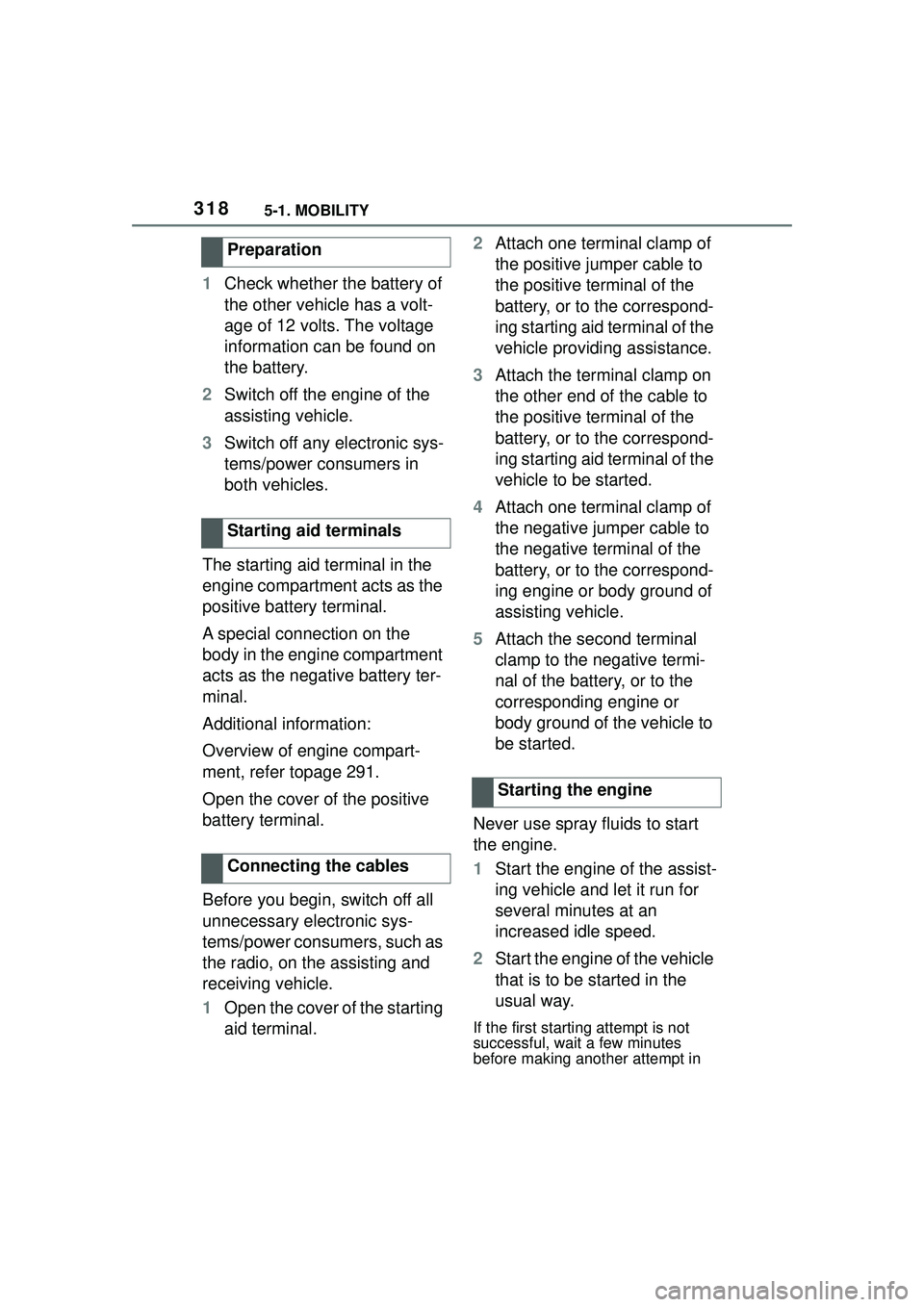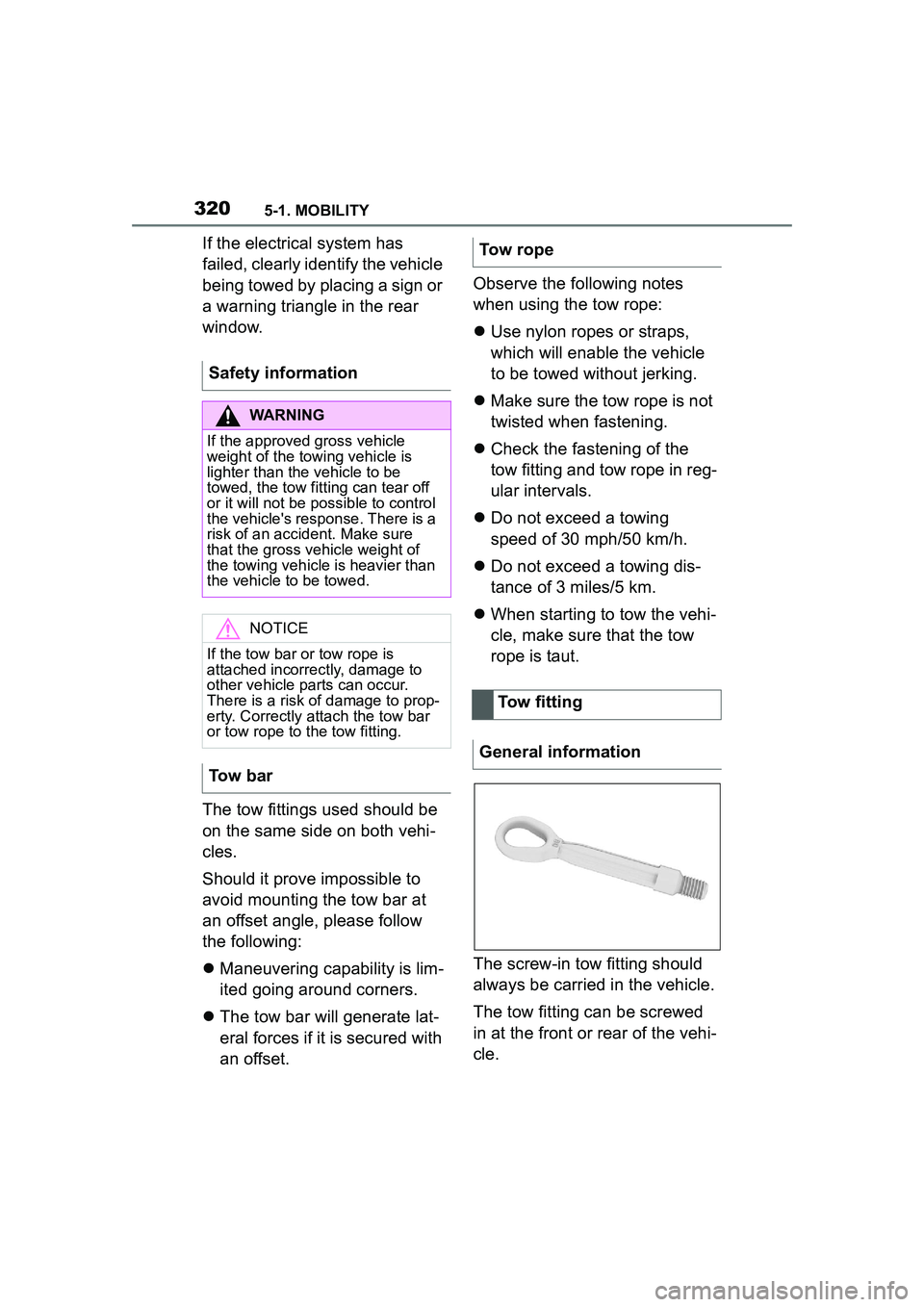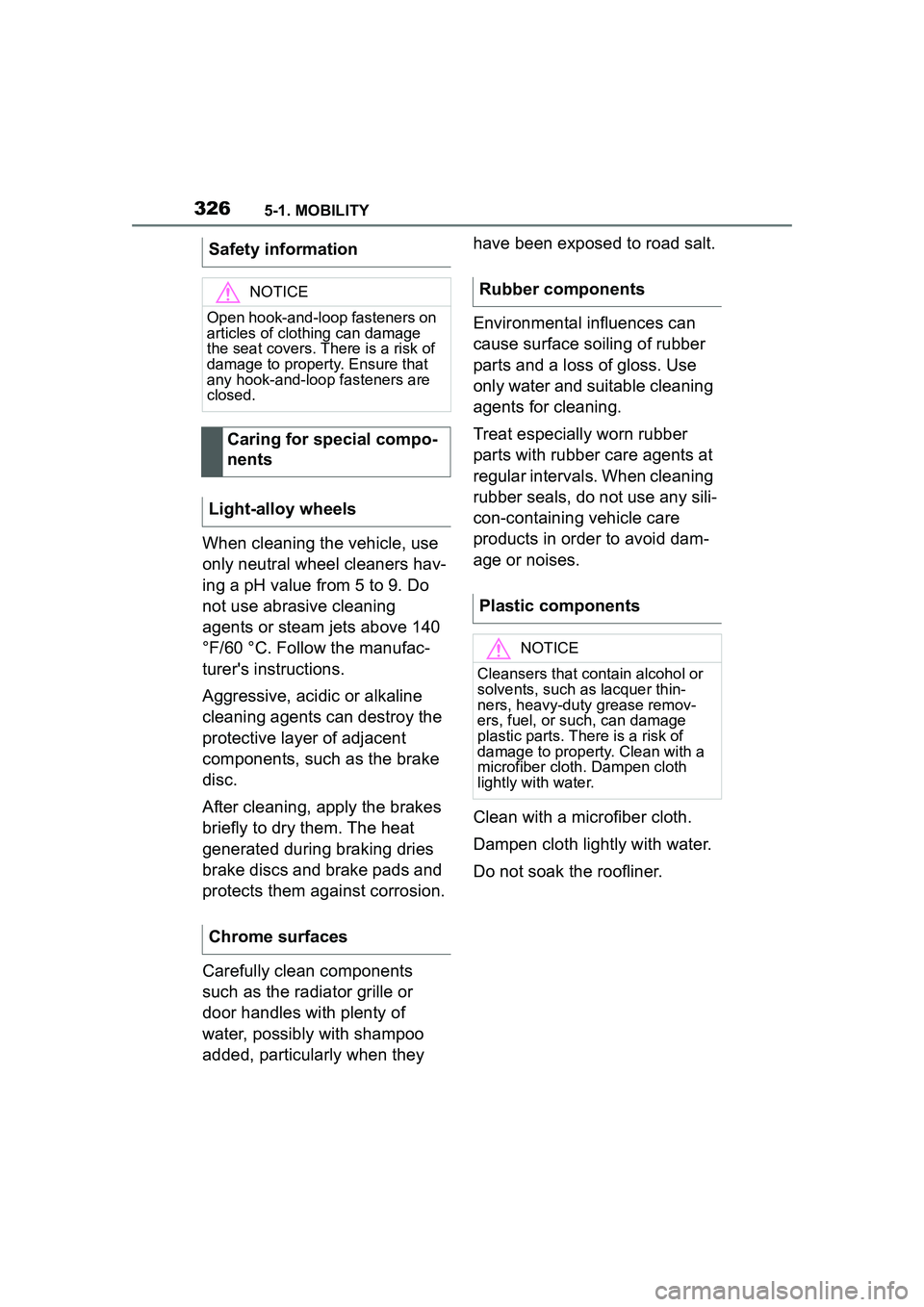Page 318 of 356

3185-1. MOBILITY
1Check whether the battery of
the other vehicle has a volt-
age of 12 volts. The voltage
information can be found on
the battery.
2 Switch off the engine of the
assisting vehicle.
3 Switch off any electronic sys-
tems/power consumers in
both vehicles.
The starting aid terminal in the
engine compartment acts as the
positive battery terminal.
A special connection on the
body in the engine compartment
acts as the negative battery ter-
minal.
Additional information:
Overview of engine compart-
ment, refer topage 291.
Open the cover of the positive
battery terminal.
Before you begin, switch off all
unnecessary electronic sys-
tems/power consumers, such as
the radio, on the assisting and
receiving vehicle.
1 Open the cover of the starting
aid terminal. 2
Attach one terminal clamp of
the positive jumper cable to
the positive terminal of the
battery, or to the correspond-
ing starting aid terminal of the
vehicle providing assistance.
3 Attach the terminal clamp on
the other end of the cable to
the positive terminal of the
battery, or to the correspond-
ing starting aid terminal of the
vehicle to be started.
4 Attach one terminal clamp of
the negative jumper cable to
the negative terminal of the
battery, or to the correspond-
ing engine or body ground of
assisting vehicle.
5 Attach the second terminal
clamp to the negative termi-
nal of the battery, or to the
corresponding engine or
body ground of the vehicle to
be started.
Never use spray fluids to start
the engine.
1 Start the engine of the assist-
ing vehicle and let it run for
several minutes at an
increased idle speed.
2 Start the engine of the vehicle
that is to be started in the
usual way.
If the first starting attempt is not
successful, wait a few minutes
before making another attempt in
Preparation
Starting aid terminals
Connecting the cables
Starting the engine
Page 320 of 356

3205-1. MOBILITY
If the electrical system has
failed, clearly identify the vehicle
being towed by placing a sign or
a warning triangle in the rear
window.
The tow fittings used should be
on the same side on both vehi-
cles.
Should it prove impossible to
avoid mounting the tow bar at
an offset angle, please follow
the following:
Maneuvering capabi lity is lim-
ited going around corners.
The tow bar will generate lat-
eral forces if it is secured with
an offset. Observe the following notes
when using the tow rope:
Use nylon ropes or straps,
which will enable the vehicle
to be towed without jerking.
Make sure the tow rope is not
twisted when fastening.
Check the fastening of the
tow fitting and tow rope in reg-
ular intervals.
Do not exceed a towing
speed of 30 mph/50 km/h.
Do not exceed a towing dis-
tance of 3 miles/5 km.
When starting to tow the vehi-
cle, make sure that the tow
rope is taut.
The screw-in tow fitting should
always be carried in the vehicle.
The tow fitting can be screwed
in at the front or rear of the vehi-
cle.
Safety information
WARNING
If the approved gross vehicle
weight of the towing vehicle is
lighter than the vehicle to be
towed, the tow fitting can tear off
or it will not be possible to control
the vehicle's response. There is a
risk of an accident. Make sure
that the gross vehicle weight of
the towing vehicle is heavier than
the vehicle to be towed.
NOTICE
If the tow bar or tow rope is
attached incorrectly, damage to
other vehicle parts can occur.
There is a risk of damage to prop-
erty. Correctly attach the tow bar
or tow rope to the tow fitting.
Tow bar
Tow rope
Tow fitting
General information
Page 326 of 356

3265-1. MOBILITY
When cleaning the vehicle, use
only neutral wheel cleaners hav-
ing a pH value from 5 to 9. Do
not use abrasive cleaning
agents or steam jets above 140
°F/60 °C. Follow the manufac-
turer's instructions.
Aggressive, acidic or alkaline
cleaning agents can destroy the
protective layer of adjacent
components, such as the brake
disc.
After cleaning, apply the brakes
briefly to dry them. The heat
generated during braking dries
brake discs and brake pads and
protects them against corrosion.
Carefully clean components
such as the radiator grille or
door handles with plenty of
water, possibly with shampoo
added, particularly when they have been exposed to road salt.
Environmental influences can
cause surface soiling of rubber
parts and a loss of gloss. Use
only water and suitable cleaning
agents for cleaning.
Treat especially worn rubber
parts with rubber care agents at
regular intervals. When cleaning
rubber seals, do not use any sili-
con-containing vehicle care
products in order to avoid dam-
age or noises.
Clean with a microfiber cloth.
Dampen cloth lightly with water.
Do not soak the roofliner.
Safety information
NOTICE
Open hook-and-loop fasteners on
articles of clothing can damage
the seat covers. There is a risk of
damage to property. Ensure that
any hook-and-loop fasteners are
closed.
Caring for special compo-
nents
Light-alloy wheels
Chrome surfaces
Rubber components
Plastic components
NOTICE
Cleansers that contain alcohol or
solvents, such as lacquer thin-
ners, heavy-duty grease remov-
ers, fuel, or such, can damage
plastic parts. There is a risk of
damage to property. Clean with a
microfiber cloth. Dampen cloth
lightly with water.